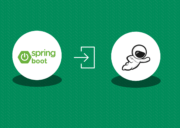
We live in an interconnected world whose fabric is wired in software threads. Application Programming Interfaces contribute to this fabric through the optimization of resources such as time and money. Thanks to the sharing of APIs, the full potential hidden inside complex platforms and ecosystems is revealed in a rich environment.
The evolution of the software paradigms in the direction given by cloud computing, microservices, and serverless computing hits the goal of what is nowadays called the API Economy. This potential can be exploited going deep inside API writing and consumption inside and outside the organization.
Publishing a set of APIs opens golden doors: it can be a source of revenue or a strong contribution to the growth of one or more communities. In both cases, there will be a net result for the publisher, be it a large company or a single professional.
Consuming other’s APIs, or publishing their own software in the form of APIs, gives a great advantage to the overall functionalities given by your software or service, that can be offered to the customers in a shorter time compared to full in-house development. Interesting data sets are also available inside the API economy. The part of your app or webpage that is executed through published APIs helps to track the value generated by every single module.IBM has an extensive portfolio of cloud-based offerings, easy to discover on a dedicated webpage. We are going to use their dedicated tools and services to show-case how easy it can be, nowadays, to work in the API economy.
APIs mean value
The success of this approach has greatly increased over the last few years. The concept of API started as a technical standpoint, to become a business matter. Many technical approaches are today included in the API space, starting from RPC and Web Sockets, SOAP and XML, event management, and many recent advancements such as GraphQL. All of them are detailed with their value-driven metrics.
The API value proposition
Let’s give the first look to the two main approaches inside the API Economy: the consumer and the seller.
If you consume somebody else’s APIs, you can make savings in many ways. Cyber-protection, speed management, and the consumption model allow for accountable savings. All of your analytics improve when you consume consistent APIs.
However, savings are not earnings. But if you publish a well-documented API with a clear price list, on the other side you can earn cash for your company. The art of publishing code is today a commodity. Think of serverless computing: you write your code, you call an API-generating tool, you write your price, and the business starts!
Earning money from an API: How developers get paid
Let’s now go a little deeper into the available business models for this economy. Charging per API call is only one possibility, but many more exist.
Selling only makes sense if someone wants to buy, and sometimes this is not the case. There are at least four different ways to attract an audience and drive revenues: free, transaction-based, paid developers, and indirect.
- Free: A free API attracts customers and increases the user community, allowing for different types of monetization.
- Developer pays: Ask a fee for each transaction. This happens in many API- and not API-related business models.
- Developer gets paid: The consuming developer is acting as your agent, selling your products or offerings. Your API usage payment to them is like a commission.
- Indirect: You use APIs to facilitate the on-boarding of users, externally to reach new customers and markets or internally to speed up adoption or the go-to-market time. The APIs are just a simpler way to integrate with your partners or contracted developers.

A good moment for the API Economy
Considering the API Economy as a technology, we could apply to it the usual methodology to define if this is a good time to make it a part of the business.
The most known description of the life cycle of technology is the Hype Cycle Report published yearly by consulting firm Gartner. There is a general chart, plus several vertical-market charts. The vertical charts have a defined timeline for each included technology.
Each Hype Cycle drills down into the five key phases of a technology’s life cycle: Innovation Trigger, Inflated Expectations, Trough of Disillusionment, Slope of Enlightenment, and Plateau of Productivity. You have expectations when everybody talks about it but only very few do it, then the interest falls close to zero. A true market begins to exist when that technology is at the lowest point of disillusionment, so you are pioneering it with a big risk of failure under the promise of the largest sums of money. Large (but not largest) sums are the goal when your chosen technology is in the enlightenment phase when you also take less risk than pioneers.
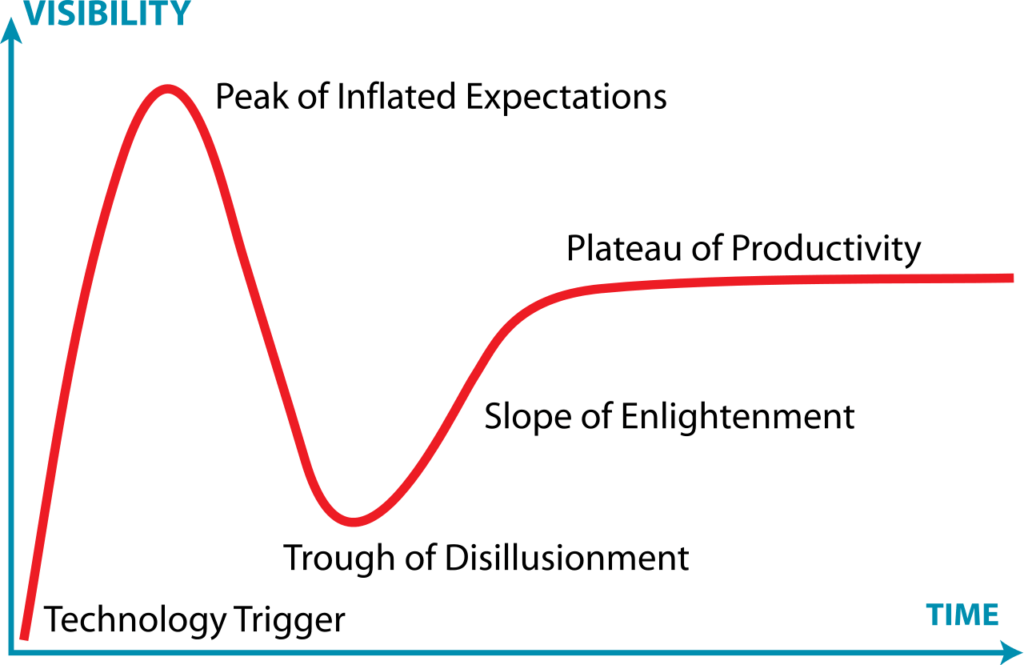
Alan Glickenhouse worked around this report, considering the API Economy as a technology.
“Looking at the report, you see that Full Lifecycle API Management is in the Slope of Enlightenment”, reads Alan’s post. “According to Gartner, API technology is climbing the slope, while microservices technology is in the Trough of Disillusionment.”
“The Slope of Enlightenment is happening as the business is becoming involved in initiatives and core strategies such as digital transformation are driving a need for stability, availability, scalability, and all the other quality of service “ilities” in projects that are built using APIs“, better explains Glickenhouse.
“Variations on this model might support a free level of low usage (freemium), or lesser functionality APIs versus higher functionality at a higher cost (tiered)”, comments Alan; “use them when they are appropriate”.
To feel how your current involvement in the API Economy fits in today’s ecosystem you can take the 90-second assessment provided by IBM at this link. Answering a few questions will give your current state and a few pieces of advice to improve.
To understand more about IBM’s thoughts on Digital Business and the API Economy visit the IBM API Economy website.
API Connect
IBM API Connect is IBM’s complete foundation to Create, Secure, Manage, Test, and Monitor APIs. A trial version of API Connect is also available through registration on the API Connect landing page. The direct link to API Connect as a cloud service can be found at this address.
API Connect allows you to manage the entire API lifecycle, from the initial development all the way through until the retirement of the application or service. An integrated tool allows to create API policy and secure traffic to the API in a visual way, without the need for writing code or interacting with the gateway.
API Connect is based upon six main modules: Developer Portal, API Manager, Gateway, Cloud Manager, Microservices App (runtime: Node.js or Java), API Designer. Enterprise security and Quota management are additional components of API Connect.
API Connect key features
API Connect is a complete solution that offers critical features that include the ability to:
- Create APIs and build microservices;
- Engage with application developers through API portals;
- Define, publish, and analyze REST and SOAP APIs;
- Establish API rate limits and provide the capability to charge back developers for API usage.
Installed locally for offline development, the developer toolkit provides a command-line interface as well as a graphical user interface, called API Designer, to quickly create and configure APIs and LoopBack applications. It gives API developers automated, model-driven tools to create new APIs and microservices based on Node.js and Java runtimes, all managed from a single unified console.

Everything you need to build APIs
The basic list of needs to build monetizable APIs is covered with API Connect. You can easily follow a well-defined path to cover all aspects of publishing and consuming this kind of code on the cloud.
Drag-and-drop policies
Save developers’ time and reduce errors with drag-and-drop assembly for many complex API policies, with no XML required
Definition templates
Enforce corporate standards by using pre-existing templates for both API definitions and API product definitions.
Simplified categorization
Use customer-defined metadata to simplify API categorization and searchability and control API gateway behavior.
Seamless experience
Move from developing APIs in the developer toolkit to publishing and managing them in API Connect without interruption.
Simple governance
Allow your lines of business to publish internal and external APIs to a single corporate portal.
Integrated security
Effortlessly secure APIs, including those created with IBM App Connect, to accelerate API delivery.
API Connect Related products
Three main solutions are normally associated with IBM’s API-publishing offering: the DataPower Gateway, the Cloud Paks, and App Connect.
What is the IBM DataPower Gateway?
IBM DataPower Gateway provides security, control, integration, and optimized access to a full range of mobile, web, application programming interface (API), service-oriented architecture (SOA), B2B and cloud workloads.
What are the IBM Cloud Paks?
IBM Cloud Paks for Integration are lightweight, enterprise-grade, modular cloud solutions, integrating a container platform, containerized IBM middleware and open source components, and common software services for development and management.
What is IBM App Connect?
IBM App Connect instantly connects applications, data, heritage systems, and modern technologies through a variety of integration styles, from traditional service-oriented architectures to modern, agile and event-driven ones, virtualizing access to data for exposure as APIs.
Accessing the IBM Cloud dashboard
Let’s see the basic steps to write a serverless function and publish it as a consumable API .
Free access to all IBM Cloud services is available from this page, and you can learn more about it in our previous article. Some services are not accessible from this free account, but it’s easy to understand the potential of the IBM Cloud offering.
Once you register your account, you have access to a dashboard.
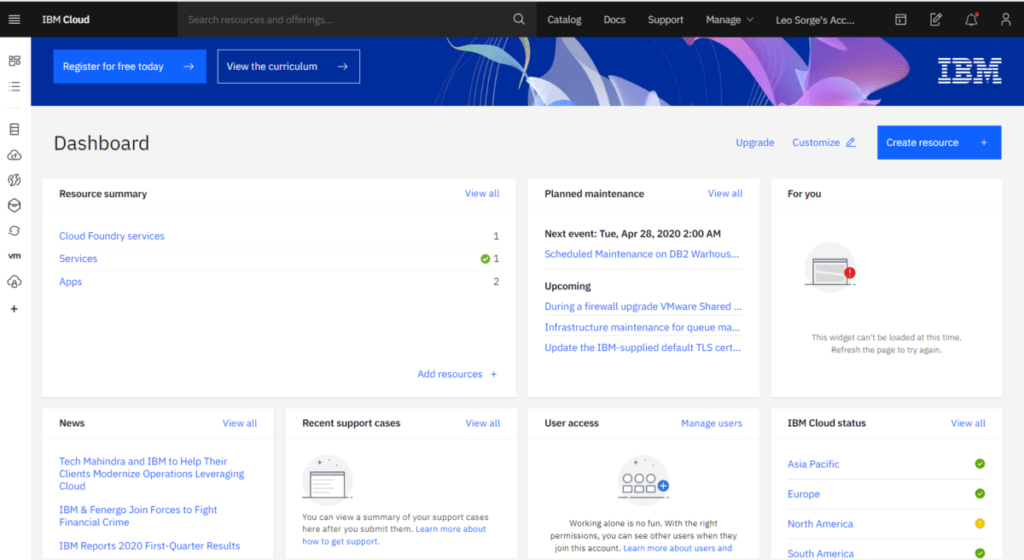
Please access the function-generating console, clicking on the circled “f” in the left vertical bar – the fifth icon starting from the top in the dashboard screenshot. Then choose “Create Action”.
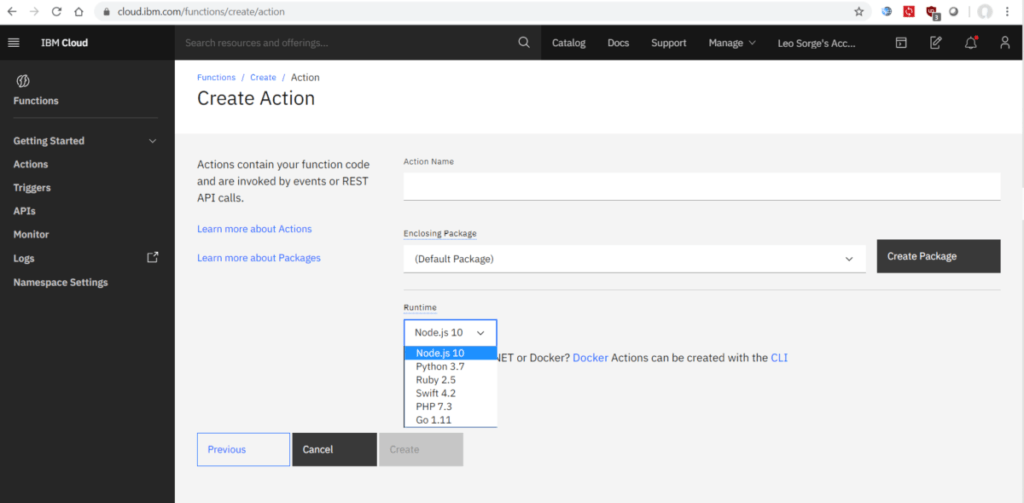
You start creating a new function and (in this example) choose Python as a runtime, configuring the environment parameters (virtual environments, modules, and the other options).
As an example, you can write a simple function in Python that reads a basic JSON file and returns its values. Name it. The IBM Cloud service immediately publishes your results on a self-generated page: check if your output is as you desired it.
Accessing the API Connect dashboard
If everything is ok, you can go to the API Connect dashboard. To reach it, you have to go to the left vertical bar again and locate the last icon, a plus sign (+). Clicking on it a larger set of options opens up: locate the API Management option and click on it.
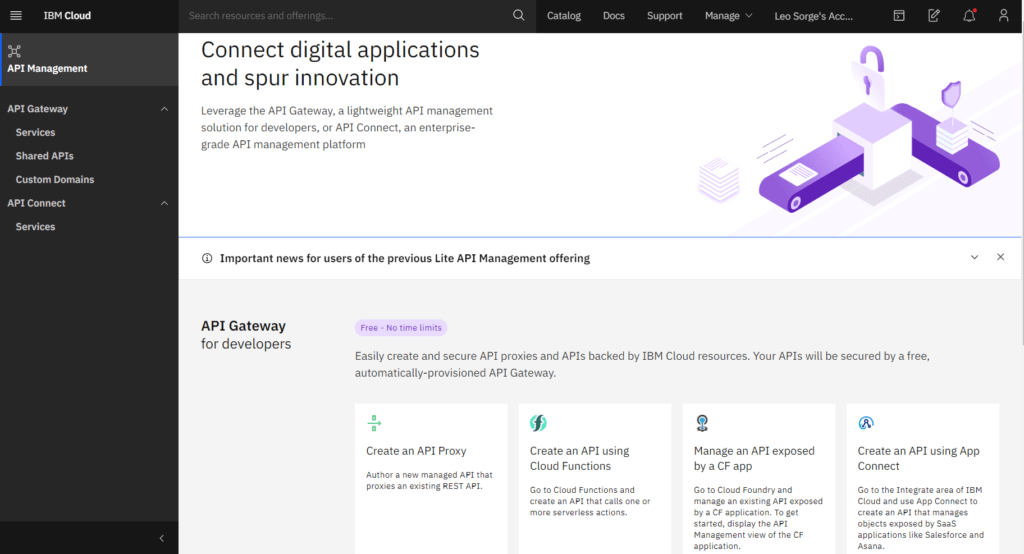
You are in the API Connect section now. Import your function and follow the suggested path: publish the API, establish the payment thresholds, and generate the documentation.

You have just generated your API in a few clicks. Easy does it!
If you want to discover more about IBM Cloud, click here!


